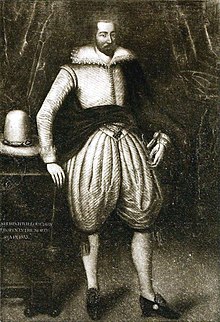Hugh Willoughby
Sir Hugh Willoughby († 1554 in the mouth of the Warsina ) was an English officer and expedition leader . He was the first Western European to look for the Northeast Passage .
Life
Willoughby fought against Scotland in the Battle of Flodden Field in 1513 and was defeated to Knight Bachelor on May 18, 1544 during a renewed campaign against the Scots . In 1553 he commanded a fleet of three ships with 111 men on board (including eleven merchants), which was supposed to find a northeast passage to China . Willoughby had not received any nautical training himself, but was accompanied by experienced captains such as Richard Chancellor and Stephen Borough , both of whom sailed on the Edward Bonaventure . Willoughby himself commanded the Bona Esperanza and Cornelius Durforth the Bona Confidentia . The ships left London on May 10, 1553 and sighted the Norwegian coast on July 14. North of Lofoten , the fleet got caught in a storm in early August, in which the Edward Bonaventure was separated from the other ships. Willoughby sailed with the remaining two ships first to the northeast, then to the southeast, in order to call at the meeting point Vardø , where the Edward Bonaventure also waited seven days. Willoughby missed the meeting point and sailed on to the northeast, where he finally encountered land at 72 degrees north latitude, but could not enter this because ice and shallow water prevented him. From today's perspective, it was Novaya Zemlya . Since Willoughby could only determine the geographical longitude very imprecisely, it is recorded as an independent island ( Willoughby's Land ) on several maps of the 16th and 17th centuries.
In search of a safe harbor for urgent repairs, the ships sailed again to the southwest to the Murman coast . The ships anchored in the mouth of the Warsina. Willoughby was forced to winter here, for which he was not adequately prepared. Since he did not keep a log , almost nothing is known about the next few months. A paper found later shows that Willoughby and most of his people were still alive in January, but when Russian fishermen found the ships in the spring of 1554, none of the 62 men were alive. Hunger, cold and scurvy were assumed to be the causes of death at the time . But there are many indications that the men died of carbon monoxide poisoning .
Richard Chancellor reached the White Sea with the Edward Bonaventure , left his ship there, traveled on to Moscow and thus opened a new trade route.
literature
- John Pinkerton: A General Collection of the Best and Most Interesting Voyages and Travels in All Parts of the World . Volume 1, London 1808, pp. 1-15
- Leanora C. Gordon: The Fate of Sir Hugh Willoughby and His Companions: A New Conjecture . In: The Geographical Journal 152 (2), 1986, pp. 243-247
- William James Mills: Exploring Polar Frontiers - A Historical Encyclopedia . tape 2 . ABC-CLIO, 2003, ISBN 1-57607-422-6 , pp. 714 (English, limited preview in Google Book search).
Web links
Individual evidence
| personal data | |
|---|---|
| SURNAME | Willoughby, Hugh |
| ALTERNATIVE NAMES | Willoughby, Sir Hugh (full name) |
| BRIEF DESCRIPTION | English navigator and expedition leader |
| DATE OF BIRTH | 15th century |
| DATE OF DEATH | 1554 |
| Place of death | Mouth of the Warsina |
